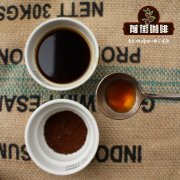Coffee varieties and producing areas Coffee varieties Tippika Ancient Tibica varieties

Professional coffee knowledge exchange more coffee bean information please follow the coffee workshop (Wechat official account cafe_style)
Coffee variety iron pickup
Typic: the oldest native variety in Ethiopia, all Arabica are derived from Tibika. The top leaf of Tiebika is bronzed and the bean body is oval or thin in shape; the flavor is elegant, but the physique is weak, the disease resistance is poor and the fruit yield is less. Excellent manor beans such as the Blue Mountains of Jamaica, Manning of Sumatra and Kona of Hawaii all belong to Tibika. One of the characteristics is that the top leaf of Tibica is bronzed.
Around 1670, an Indian monk named Baba Bodan risked his life to steal a few coffee seeds from Yemen and take them back to his hometown for planting.
When the Dutch East India Company heard the news, the Dutch East India Company bought some seeds from the Indians and planted them in its colonies of Java, Ceylon and Indonesia, which was a great success, and the history of growing coffee on colonial estates began.
Merchant ships of the Dutch East India Company
According to genetic engineering tests of modern science and technology, the coffee seeds stolen by Baba Bodan are the origin of the modern coffee growing industry. This includes two descendants of Arabica: "Bourbon" and "Typica". The Dutch got the coffee seeds, all of which belonged to the Tibica family.
After that, the Dutch transported the Tibica saplings to the greenhouse of the botanical garden in Amsterdam for cultivation. During a friendly meeting, King Louis XIV of France received a gift from the mayor of Amsterdam-a coffee sapling.
Tiebika grows coffee beans
Louis XIV planted the coffee sapling in the back garden of Versailles as a souvenir. Later, the tree bore a lot of fruit and bred some seedlings. Louis XIV personally baked and brewed these coffee beans to feast guests, so at that time many aristocrats should be able to boast: "the king personally made coffee for me."
The coffee trade can bring huge profits and attract the attention of adventurers. Gabriel Matthew Dikru, a low-ranking French naval officer, tried to steal a batch of coffee saplings from the royal garden and took them on board to the new world of America full of infinite possibilities.
Matthew Dikrou went through untold hardships along the way to escape from crises such as pirates, storms, and running out of food and water. When he finally got away with setting foot on the land of America, those precious coffee saplings had been lost, leaving only the last half-dead one.
So Dikrou rushed the sapling to the land for careful care and managed to save it. The place where this sapling is planted is called Martinique Island.
In 1726, coffee was first harvested on Martinique Island. Fifty years later, coffee production here reached 19 million pounds, far surpassing the previous largest producer, Java in Southeast Asia.
In the late 18th century, the coffee industry developed rapidly in Brazil and Colombia, and further spread to Central America. The British brought coffee to Jamaica from Martinique in 1730, arrived in Saint Dominica in 1735 and spread from Dominica to Cuba in 1748
Until the 1940s, the vast majority of American coffee plantations mainly grew Tibica. However, because the yield of Tibica is not high, and its disease resistance is relatively low, it is gradually replaced by other varieties in many producing areas.
END
Important Notice :
前街咖啡 FrontStreet Coffee has moved to new addredd:
FrontStreet Coffee Address: 315,Donghua East Road,GuangZhou
Tel:020 38364473
- Prev

What's the difference between the treatment of coffee beans in the sun, washing and honey?
Professional coffee knowledge exchange more coffee bean information Please follow the coffee workshop (Wechat official account cafe_style) Coffee is mainly treated in three categories: sun drying, washing, and honey treatment. The sun drying method is to directly expose the coffee cherries before removing the shell and pectin layer; the water washing method is to screen the coffee pulp before exposure and ferment to remove the pectin layer; the honey treatment rule is between the sun.
- Next

Variants of coffee varieties in the world, genetic mutants, pointed bourbon.
Professional coffee knowledge exchange more coffee bean information please follow the coffee workshop (Wechat official account cafe_style) Coffee variety gene mutant Bourbon Pointu: found in Bourbon Island in 1810, the bean body changed from round to pointed, the caffeine content is only half; but the quantity is small, the body is weak, and it is extremely precious (mostly cultivated in the laboratory). Elephant bean (Maragogype)
Related
- Detailed explanation of Jadeite planting Land in Panamanian Jadeite Manor introduction to the grading system of Jadeite competitive bidding, Red bid, Green bid and Rose Summer
- Story of Coffee planting in Brenka region of Costa Rica Stonehenge Manor anaerobic heavy honey treatment of flavor mouth
- What's on the barrel of Blue Mountain Coffee beans?
- Can American coffee also pull flowers? How to use hot American style to pull out a good-looking pattern?
- Can you make a cold extract with coffee beans? What is the right proportion for cold-extracted coffee formula?
- Indonesian PWN Gold Mandrine Coffee Origin Features Flavor How to Chong? Mandolin coffee is American.
- A brief introduction to the flavor characteristics of Brazilian yellow bourbon coffee beans
- What is the effect of different water quality on the flavor of cold-extracted coffee? What kind of water is best for brewing coffee?
- Why do you think of Rose Summer whenever you mention Panamanian coffee?
- Introduction to the characteristics of authentic blue mountain coffee bean producing areas? What is the CIB Coffee Authority in Jamaica?

